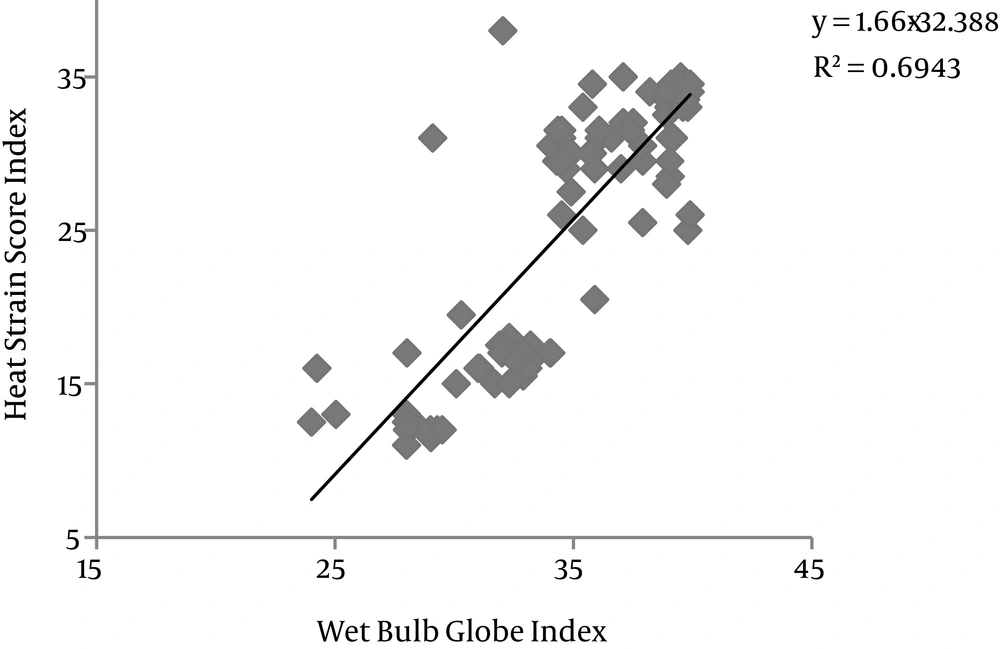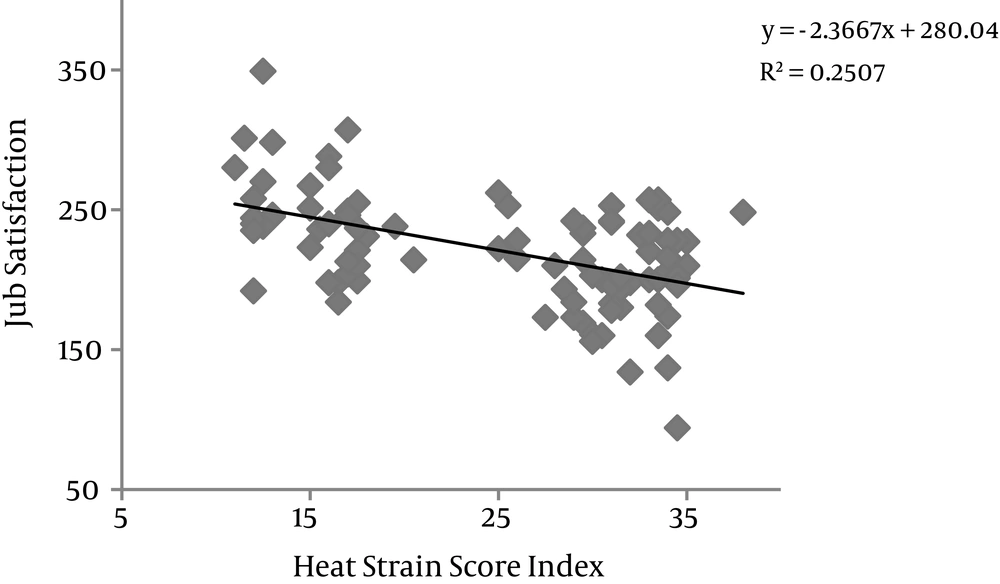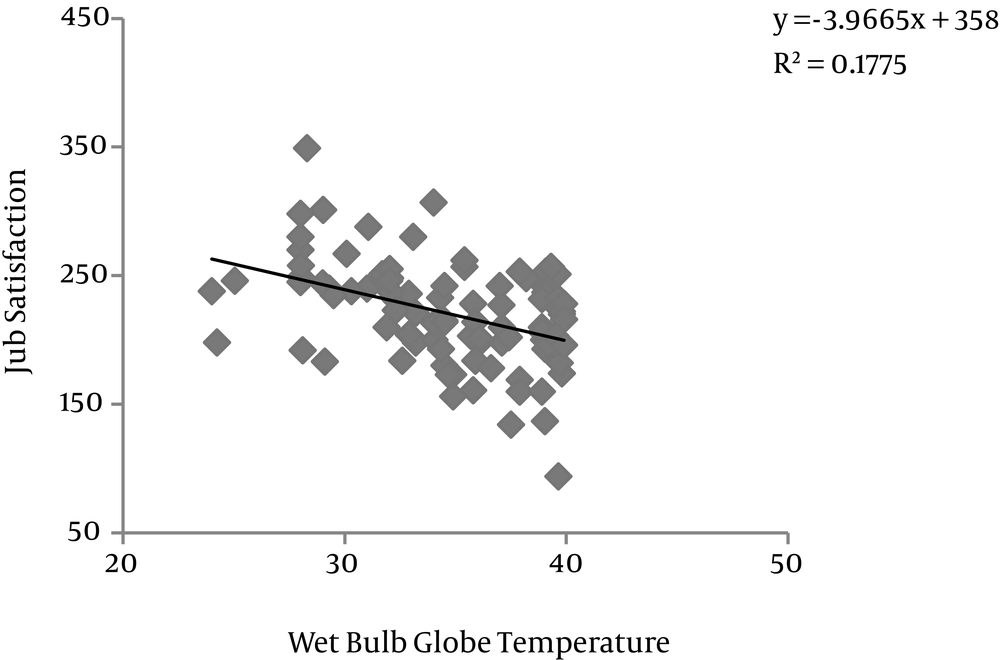1. Background
Heat is amongst harmful physical agents in workplaces (1). There are hot environments in many industries e.g. mining, glassmaking, iron and steel industries. Working in hot environments increases core body temperature (2). Heat is a known hazard for personnel who work in industries with melting processes (3). In such industries, environmental temperature is high so that the body cannot transfer to the its environment and in result some physiological problems are provided by the heat. Studies have shown that occupational diseases, productivity decrease and safety problems are higher in people who work in hot environments (4). Heat provides some job problems and increases the risk of accidents (5). It has been determined that the chance of hazardous accidents and behaviors in the environments with WBGT index increases to more than 24°C (6). Work in a safe physical condition supports the correct performance of workers. Technology development could be followed by improvement in physical conditions e.g. temperature, noise and lighting, which cause improvement in performance (7). A number of researches have studied the psychological effects of the environment on other environment features and in some other studies the physical effects of the environment on psychological factors (8-10). Recently many studies on workplace psychology have been conducted that focused highly on the environment physical conditions and job performance (4). Occupational stress is amongst psychological problems. Neural stress or pressure is one of the very acute problems in today’s organizations that damages physical and psychological health of the work force (11). There are no accepted popular definitions about stress. According to the ILO, stress refers to contact with harmful physical and emotional conditions (12). Based on conducted studies, it has been proved that stress damages human physical and psychological-mental health and is a contributing factor in most known diseases (13). Psychological damages (occupational stress, weak performance and job dissatisfaction) occur in the presence of unhealthy conditions in the environment and affect the workers’ behaviors (12). In many countries, researchers have been conducted about the effect of heat on performance and other psychological factors in the two recent decades yet enough documents and evidences have not been recorded and collected (14). Attention to workplace heat is not only important to workplace health but is also a contributing factor for better production and facilitates workers job performance (15). Therefore, obtaining a healthy work environment that means an environment bearing low psychological and physical disorders is the main purpose of such studies (7). A hot environment is a kind of unhealthy environment and in the recent years its psychological effects on workers have increased. Attention to the topic of work environment heat does not only emphasize on workers’ health but pays attention to the individuals activity to produce high quality and quantity products and facilitate workers’ job performance (1-5). The results of this research can present some suggestions related to improvement of environment heat condition in order to improve job performance, decrease occupational stress and increase job satisfaction.
2. Objectives
This research aimed to investigate the effects of heat stress on job satisfaction, job performance and occupational stress in casting workers.
3. Patients and Methods
This research was a descriptive-analytical study and data were collected based on enumeration in a casting industry with 100 workers, and 94 questionnaires were completed. Selection and number of samples was based on similar empirical studies (5, 16). The people under study in this research were diagnosed physically based on performed examinations and people were in the age range of 35 to 50 years old. In this research environment heat condition and peoples’ feeling about it was measured along with its effect on some psychological and behavioral factors and measurement instrument; HSSI and WBGT index were determined with questionnaires of occupational stress, job performance and satisfaction. Firstly, questionnaires and method of filling them was explained to the workers. Amount of heat by the HSSI questionnaire was classified in three levels (1-3). It should be noted that each of the two series of the questionnaires should be completed simultaneously. In the next stage, the distributed and completed questionnaires were collected and the obtained data was entered in the SPSS software and was analyzed using descriptive statistics, Pearson’s correlation and chi-square test. Validity and reliability of questionnaires of occupational stress, job performance, job satisfaction and HSSI were measured by previous studies (6, 17, 18), respectively. To determine individuals’ occupational stress, the occupational stress questionnaire that is measured by Esfandyar Azad Marzabbadi in 2010 was used (17). This questionnaire includes scopes of demand, control, authorities support, colleagues support, changes, role and communication. To determine level of individuals’ job performance the job performance questionnaire, validated by Salehi using Cronbach’s alpha and split-half method, was used (19). The validity coefficient has been determined as 0.86 based on Cronbach’s and 0.78 based on split-half. This questionnaire measures employees’ performance in the scope of their job tasks and organizational role. The scoring method of this 15-question questionnaire is multi-choice and its choices are always, often, sometimes and seldom. The scores of 0, 1, 2 and 3 are assigned to every one of the choices so range of grades and scores of each test is between 0 and 45. The JDI questionnaire that has been validated in the Shahid Chamran University of Ahvaz (18) was used to determine the amount of individuals' job satisfaction. This questionnaire including five scopes has a reliability coefficient of 0.94 and validity coefficient of 0.66. The HSSI questionnaire validated by Dehghan was applied to measure the perceptual of heat stress (5, 6). The validity coefficient has been determined as 0.9 according to Cronbach's alpha. This questionnaire has 18 items. Each question has multiple choices with different grading.
4. Results
Frequency distribution of heat stress score index and each of job satisfaction, performance and stress cases and each of the job satisfaction scopes along with Pearson’s correlation coefficient to determine the relationship between them is shown in Table 1.
| HSSI | No. (%) | Variables | Mean | Standard Deviation |
|---|---|---|---|---|
| Low | 13 (13.8) | Job stress | 50.8 | 5.85 |
| Moderate | 22 (23.4) | |||
| High | 59 (62.8) | Job performance | 66.6 | 12.1 |
| Total | 94 (100) | Job satisfaction | 53.7 | 17.5 |
Frequency Distribution of Heat Stress Situation and Standard Deviation and Mean of Job Satisfaction, Performance and Occupational Stress Score
The result of Table 1 shows that most people had a high sense of heat and most people had moderate job satisfaction, performance and occupational strain.
The results of Table 2 show that most people are intermediately satisfied with their job, very highly satisfied with direct responsibility of their job, very highly satisfied with their coworkers, have low satisfaction with improvement conditions and salaries and benefits and have intermediate or low satisfaction from their work conditions in the present environment. Also Spearman’s correlation coefficient showed that there is an indirect significant relationship between HSSI and job scope among all scopes of job satisfaction (r= - 0.639, P < 0.001). In other words personnel satisfaction from job is decreased when heat stress is increased.
| Variables | Job Satisfaction | HSSI | ||
|---|---|---|---|---|
| Mean | Standard Deviation | P Value | R | |
| Job | 48.99 | 17.46 | < 0.001 | - 0.639 |
| Direct responsible | 74.2 | 20.38 | 0.205 | - 0.132 |
| Co worker | 70.19 | 23.56 | 0.021 | - 0.237 |
| Improvement | 43.16 | 27.11 | 0.001 | - 0.332 |
| Salaries and benefits | 29.93 | 19.56 | 0.033 | - 0.22 |
| Work condition | 42.29 | 22.14 | 0.016 | - 0.248 |
Standard Deviation and Mean of Scopes Score of Job Satisfaction and Spearman Correlation Coefficient Between Heat Strain Score Index And Its Scopes
The results of Table 3 showed that there was a direct relationship between heat strain score index and WBGT and there was an indirect relationship between it and job satisfaction. There was no significant relationship between it and job performance and occupational stress.
| Heat stress score | HSSI | WBGT | ||
|---|---|---|---|---|
| variables | P Value | r | P Value | R |
| WBGT | < 0.001 | 0.83 | ||
| Job satisfaction | < 0.001 | - 0.487 | < 0.001 | - 0.421 |
| Occupational stress | 0.46 | 0.08 | 0.14 | 0.153 |
| Job performance | 0.65 | 0.05 | 0.31 | 0.11 |
Pearson and Spearman Correlation Coefficient Between Heat Strain Score Index, Heat Stress Situation Score And Wet Bulb Globe Temperature Score With Job Satisfaction
Spearman correlation coefficient showed that there was a direct relationship between HSSI and WBGT (r = 0.83, P < 0.001). In other words feeling of heat is increased as a result of increased environmental temperature (Figure 1) and there was an indirect relationship between HSSI and job satisfaction (r= -0.487, P < 0.001) (Figure 2). In other words personnel satisfaction from job was decreased with the increase in feeling of heart. Also, Pearson correlation coefficient showed that there was an indirect relationship between WBGT and job satisfaction (r = -0.421, P < 0.001). In other words job satisfaction was decreased when amount of heat was increased (Figure 3).
5. Discussion
In many countries like Iran a significant percentage of work force are working in workshops that have a capacity of less than 100 individuals. In the scope of the measured psychological disorders in the present study, individuals' job satisfaction has a significant relationship with level of heat and feeling of heat. The result obtained from the study of the relationship between heat stress and job satisfaction showed P < 0.001 and this fact proved the significant effect of heat stress on job satisfaction and also, Spearman correlation coefficient showed that among all job satisfaction scopes, the heat stress situation HSSI and job scope had indirect relationships (r = - 0.639,P < 0.001). In other words, personnel satisfaction from their job is decreased as a result of increase in heat, meaning control of temperature conditions should be considered as a priority of the control actions in order to decrease job satisfaction level. Ramsy found that there is a significant relationship between temperature increase and unsafe behaviors. This point caused environments with high temperature to be paid greater attention (20). Results of the Kwon Hancock studies showed that heat can lead to psychological disorders in an individual by producing rapid changes in the temperature of the heart, blood, and then core temperature and also, Hancock claimed that psychological disorders occur in an individual due to change in their core temperature. Therefore, psychological injuries occur in the environment in the presence of unhealthy conditions and this affects workers' behavior (12). Also the results of some studies indicate that job satisfaction is related to general happiness, mental health, and longer life expectancy. According to the performed study titled the relationship between job satisfaction and psychological health, it was determined that job satisfaction is an effective factor on mental health (18). Therefore, regarding the present study results we can also say the psychological conditions of the personnel improved following improvement in temperature conditions and increase of job satisfaction. Observation of the conducted studies on heat stress showed that a small number of studies have been done to investigate the relationship or effect of heat stress on psychological climate of the organization and only a few suggestions have been proposed in some articles. With regards to the fact that Iran is amongst developing countries, it is more important to study this issue. The present study did not show a significant difference between workers performance due to work at temperatures ranging between 24.01 and 39.9°C. This result is not consistent with results of Kwon, Ramsy and Hancock because of limited work and existence of regular breaks (every 30 minutes working at temperatures higher than 30°C, 10 minutes break in the free air). According to 150 studies performed by Ramsy and Kwon, it was determined that job performance is decreased without respect to the exposure time in complicated tasks with WBGT index equal to 30-33°C. According to the results of this study it was recommended to maintain body temperature at 38°C in doing these tasks. Studies on simple tasks showed that these tasks need deep temperature of 38.5°C (20). Studies conducted by Hancock showed that exposure to heat in a short period of time causes increase in performance in tasks that require low mental activity. Exposure to heat decrease when performing a task increases error even in skillful workers (21, 22). Another study on physical condition of the work environment showed that decrease in job quality has impacts on employees' motivation, job satisfaction and performance. Physical environment has a vital role in job performance and satisfaction of individuals (4). In a study conducted by Hancock, the results showed that heat can decrease performance but in some cases performance was increased. Some believe that this difference is due to some unknown mechanisms of heat exposure (20). Other studies have reported psychological injuries created for people who work in mines (2), yet no research has been done on psychological injuries caused for founders as a result of working in hot environments. In the two recent decades, many researches have been conducted about psychological problems caused by heat but no significant documents have been recorded and collected (20). Workers of hot industries like metal and glass melting are in different conditions to measure heat stress (23). To measure level of heat there are different tools and one of them is questionnaire. Questionnaire is a kind of tool to show physical and psychological condition of work environment. There are many researches that show questionnaires are tools that show the relationship between physical and emotional conditions (24). The selected method in this design to measure psychological factors and heat stress was the HSSI questionnaire and WBGT index. To assess heat stress, the HSSI questionnaire was used because this method is not limited to collecting information but has high sensitivity and is universal, rapid, easy and accessible. The research performed by Dehghan et al. has proved a strong relationship between HSSI and WBGT (5, 25). The present study showed a strong direct relationship (r = 0/83, P < 0/001) between HSSI and WBGT. As observed, the relationship and comparison of measurement methods and level of heat in different situations and also effect of heat on different body parts have been shown by different studies yet this research investigated the level of heat effect on job performance, stress and satisfaction. The obtained results suggested that heat has an impact on job satisfaction but has no significant impact on job performance and stress. The result of studying the relationship between job stress and heat in this research showed that heat has no significant impact on job stress of workers. The reason for this lack of effect can be related to regular breaks and limited work field. Many studies have been conducted on job stress and only its relationship with other psychological factors has been measured like several studies that showed job stress has a direct relationship with job fatigue (26, 27). According to the results of this study, it is recommended to pay attention to heat stress category in designing a system in order to improve psychological wellbeing of the employees. This prevents the occurrence of disorders and can result an effective, buoyant and lively work force and finally a more healthy family and society. During implementing this project it was determined that workers and employees do not transfer their sadness to their employer due to working in inappropriate work situations like high heat. It is clear that such actions lead to decreased productivity, job satisfaction and services quality. Therefore, workers are suggested to decrease these disorders that result from heat stress of workplace by transferring mental-neurological problems to their employer. Also, presence of expensive psychological diseases due to work among workers and employees shows that managers do not pay attention to the heat stress category so it is recommended to use the following solutions in order to encourage managers and engineers for paying attention to this issue when they are designing an organization:
1- Transferring this statistic to managers.
2- Training necessary courses about preventing and controlling side effects resulted from heat to workers and employers.
3- Increasing implementation of similar research.
4- Preparing and executing written instructions about working in hot environments.
5- All workers should pass the stage of compliance with heat before they start their work.
6- Implementing engineering control actions is one of the most effective procedures of heat control that should be paid attention.
We hope to have proved the importance of heat stress in Iran through studying the effect of heat stress on different aspects of organization and also to implement this research in a wider field of work and other kinds of industries.
5.1. Conclusion
The results showed that focus in studies conducted on heat was on the relationship, comparison of measurement methods, level of heat in different situations, and also effect of heat on different body organisms yet the focus in this research was on the level of the heat effect on job performance, stress and satisfaction. The results reported the effective role of heat on job satisfaction, and that there is an indirect relationship between Heat Stress Score Index (HSSI) and job scope among all job satisfaction scopes. In other words, personnel satisfaction from their job reduces as a result of increase in heat in the environment but it has no significant impact on job performance and stress. The present study confirmed a strong relationship between WBGT and HSSI.


